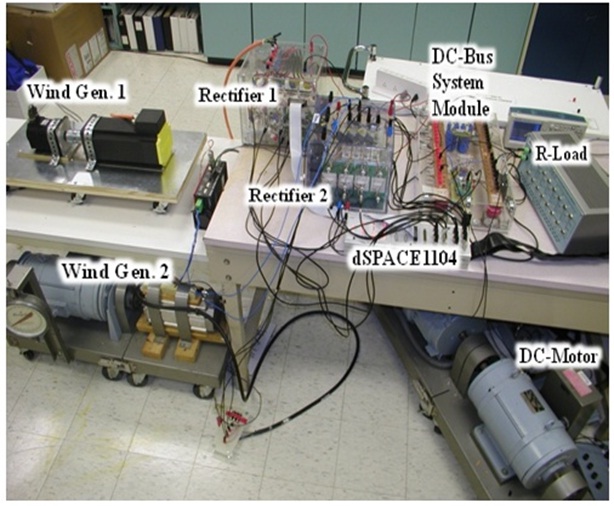Abstract:
This study presents a performance analysis of a highly integrated dc-bus system module that:
- Introduces a solution for medium & low voltage DC distribution applications.
- It is designed for applications requiring a single bus solution to control up to twelve DC-sources sharing same dc-bus and having same dc-voltage level.
- Designed to interface with various power converter modules.
- It has ability for parallel integrated renewable sources connection representing DC-microgrid.
Introduction:
Parallel connection of multi sustainable energy systems is one useful method for solving the high power requirements. Connecting modular unit systems in parallel is an efficient and reliable method of increasing the power ratings of the modular units limited by the voltage and current limits of semiconductor power switches [1], [2]. For this reason, parallel converters and inverters have been a viable alternative method of satisfying system power requirements beyond the capacity of the largest modular unit system. Parallel converters and/or inverters are also used for reducing harmonics of PWM switching frequency, and increasing available output voltage and frequency [3]. Research interest in three-phase (PWM) rectifiers (ac/dc converters) has grown rapidly due to their:
- Power regeneration capabilities
- Control of dc-bus voltage
- Low harmonic distortion of input currents
- High power factor (usually, near unity) [4].
System Description:

System & Modeling control:

Test Results:
A prototype experimental setup is designed and implemented in order to investigate the performance of the overall proposed system, including a digital signal processor (DSP TMS320F240) as the control heart of the proposed system and all the interfacing circuits to the analog Power circuits.

fig: The experimental setup of the overall WECS configuration
- DC Reference change test:

Converter output Voc Ref & Act. Generator line current Generator Vph & Il showing unity power factor at 60Hz
- Load variation test

fig: Converter variable response under load step change
- Generator voltage and frequency variation test

fig:Converter response under wind speed variation. (a) Falling edge (b) Rising edge response
Efficiency:
The average efficiency is about 97.2% along the load range. This demonstrates the expected improvement if compared with similar works.

fig: Efficiency versus output power curve
Conclusion:
- The use of parallel converters provides high reliability and high power capability (6.6 kW)
- The generator line currents have acceptable THD with a simple control circuit (3.98%)
- This technique achieved UPF operation (PF=0.998) which leads to economical utilization for the wind generator
- Very fast transient response (0.1 sec) under different possible conditions
- High efficiency (above 96% for wide power range)
References:
[1] Y. Chen and K. M. Smedley, “Parallel Operation of One-Cycle Controlled Three-Phase PFC Rectifiers,” IEEE Trans. on Ind. Elect., vol. 54, no. 6, pp. 3217-3224, Dec 2007.
[2] S. K. Mazumder, “Continuous and discrete variable-structure controls for parallel three-phase boost rectifier,” IEEE Trans. Ind. Electron., vol. 52, no. 2, pp. 340–354, Apr. 2005.
[3] Mariano López, Luis García de Vicuña, Miguel Castilla, Pedro Gayà, and Oscar López , “Current Distribution Control Design for Paralleled DC/DC Converters Using Sliding-Mode Control” IEEE Trans. on Ind. Elec., vol.51, no.2, pp. 419-428, Apr. 2004.
[4] K. Sheng, B. W. Williams, and S. J. Finney, “A Review of IGBT Models,” IEEE Tran. On Power. Electron. , vol. 15, no. 6, Nov. 2000.


